light VAUXHALL ZAFIRA 2014 Owner's Manual
[x] Cancel search | Manufacturer: VAUXHALL, Model Year: 2014, Model line: ZAFIRA, Model: VAUXHALL ZAFIRA 2014Pages: 217, PDF Size: 7.85 MB
Page 3 of 217

Introduction.................................... 2
In brief ............................................ 6
Keys, doors and windows ............26
Seats, restraints ........................... 44
Storage ........................................ 67
Instruments and controls .............77
Lighting ...................................... 108
Climate control ........................... 116
Driving and operating .................124
Vehicle care ............................... 151
Service and maintenance ..........191
Technical data ........................... 195
Customer information ................208
Index .......................................... 210Contents
Page 13 of 217

In brief11
1Light switch ........................ 108
Instrument illumination .......113
Rear fog light ....................... 112
Front fog lights ...................111
Headlight range
adjustment ......................... 109
2 Side air vents ...................... 122
3 Turn and lane-change
signals, headlight flash,
low beam and high beam ...111
Exit lighting .......................... 114
Parking lights ...................... 112
Cruise control ....................... 92
4 Steering wheel controls ........77
5 Horn ...................................... 78
Driver airbag ......................... 59
6 Instruments .......................... 83
7 Windscreen wiper,
windscreen washer
system, headlight washer
system .................................. 78
8 Centre air vents ................... 1229Left heated seat ....................49
Deflation detection system ..175
Tyre pressure monitoring
system ................................. 174
Ultrasonic parking assist ......89
Hazard warning flashers .....111
Central locking system ..........31
Sport mode ........................... 89
Right heated seat ..................49
10 Info-Display ........................... 93
Trip computer ...................... 102
Electronic climate control
system ................................. 119
11 Front passenger airbag .........59
12 Glovebox .............................. 67
13 Infotainment system ..............10
14 Climate control system ........ 11615Selector lever, manual
transmission ....................... 133
Manual transmission
automated ........................... 134
Automatic transmission .......128
16 Ashtray .................................. 82
17 Start/Stop button .................. 28
18 Accelerator pedal ................124
19 Ignition switch with
steering wheel lock .............125
Sensor panel for
emergency operation of
Open&Start system ..............28
20 Brake pedal ......................... 138
21 Clutch pedal ........................ 124
22 Steering wheel adjustment ...77
23 Bonnet release lever ...........153
Page 14 of 217

12In briefExterior lighting
Turn light switch
7=Off8=sidelights9=low beamAUTO=Automatic light control
Press light switch
>=Front fog lightsr=Rear fog light
Lighting 3 108, Headlight warning
device 3 100.
Headlight flash, high beam and
low beamHeadlight flash=Pull leverHigh beam=Push leverLow beam=Push or pull lever
High beam 3 109, Headlight flash
3 109.
Turn and lane-change signalsTo the right=Lever upTo the left=Lever down
Turn and lane-change signals
3 111.
Page 16 of 217
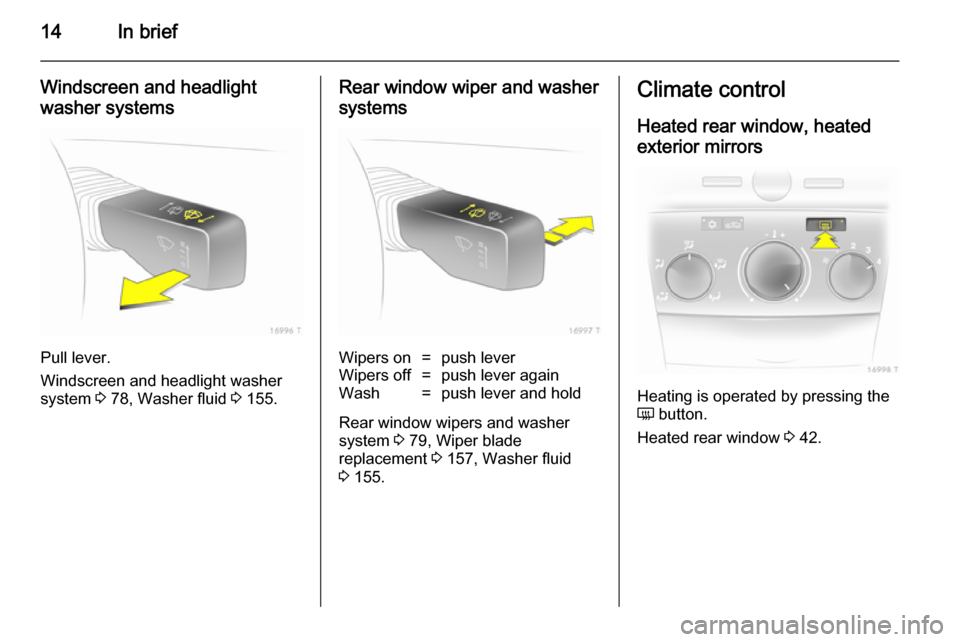
14In brief
Windscreen and headlight
washer systems
Pull lever.
Windscreen and headlight washer
system 3 78, Washer fluid 3 155.
Rear window wiper and washer
systemsWipers on=push leverWipers off=push lever againWash=push lever and hold
Rear window wipers and washer
system 3 79, Wiper blade
replacement 3 157, Washer fluid
3 155.
Climate control
Heated rear window, heatedexterior mirrors
Heating is operated by pressing the
Ü button.
Heated rear window 3 42.
Page 18 of 217
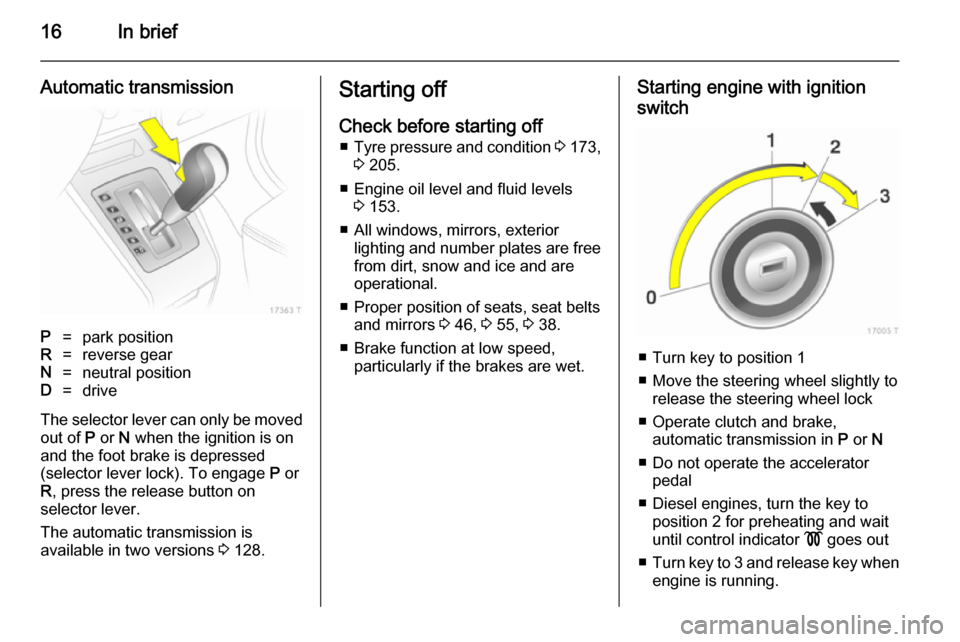
16In brief
Automatic transmissionP=park positionR=reverse gearN=neutral positionD=drive
The selector lever can only be movedout of P or N when the ignition is on
and the foot brake is depressed
(selector lever lock). To engage P or
R , press the release button on
selector lever.
The automatic transmission is
available in two versions 3 128.
Starting off
Check before starting off ■ Tyre pressure and condition 3 173,
3 205.
■ Engine oil level and fluid levels 3 153.
■ All windows, mirrors, exterior lighting and number plates are free
from dirt, snow and ice and are
operational.
■ Proper position of seats, seat belts and mirrors 3 46, 3 55, 3 38.
■ Brake function at low speed, particularly if the brakes are wet.Starting engine with ignition
switch
■ Turn key to position 1
■ Move the steering wheel slightly to release the steering wheel lock
■ Operate clutch and brake, automatic transmission in P or N
■ Do not operate the accelerator pedal
■ Diesel engines, turn the key to position 2 for preheating and wait
until control indicator ! goes out
■ Turn key to 3 and release key when
engine is running.
Page 19 of 217
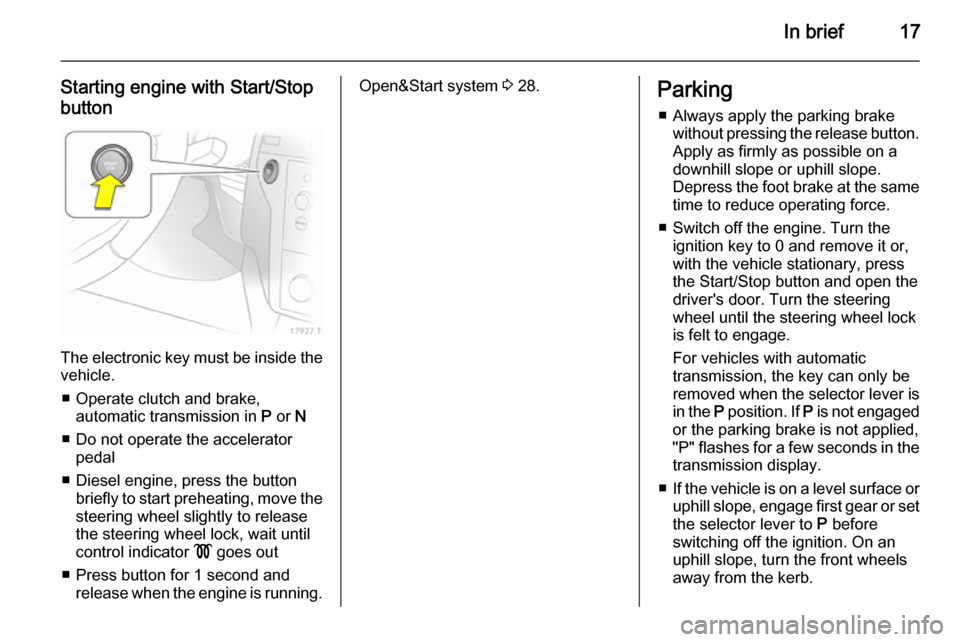
In brief17
Starting engine with Start/Stop
button
The electronic key must be inside the
vehicle.
■ Operate clutch and brake, automatic transmission in P or N
■ Do not operate the accelerator pedal
■ Diesel engine, press the button briefly to start preheating, move thesteering wheel slightly to release
the steering wheel lock, wait until
control indicator ! goes out
■ Press button for 1 second and release when the engine is running.
Open&Start system 3 28.Parking
■ Always apply the parking brake without pressing the release button.Apply as firmly as possible on a
downhill slope or uphill slope.
Depress the foot brake at the same
time to reduce operating force.
■ Switch off the engine. Turn the ignition key to 0 and remove it or,
with the vehicle stationary, press
the Start/Stop button and open the
driver's door. Turn the steering
wheel until the steering wheel lock
is felt to engage.
For vehicles with automatic
transmission, the key can only be
removed when the selector lever is in the P position. If P is not engaged
or the parking brake is not applied,
"P" flashes for a few seconds in the transmission display.
■ If the vehicle is on a level surface or
uphill slope, engage first gear or set the selector lever to P before
switching off the ignition. On an
uphill slope, turn the front wheels
away from the kerb.
Page 24 of 217
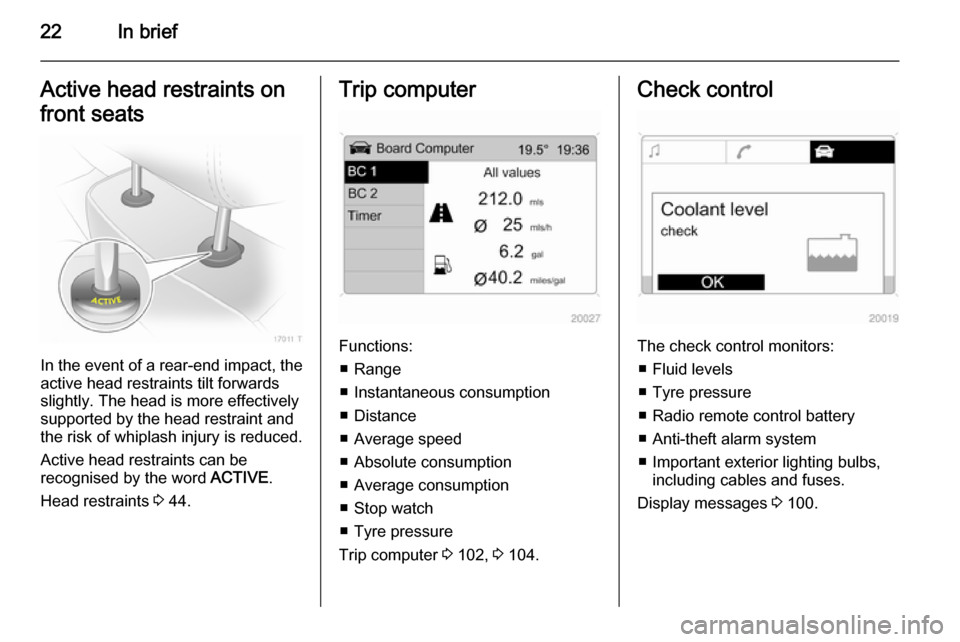
22In briefActive head restraints on
front seats
In the event of a rear-end impact, the active head restraints tilt forwards
slightly. The head is more effectively
supported by the head restraint and
the risk of whiplash injury is reduced.
Active head restraints can be
recognised by the word ACTIVE.
Head restraints 3 44.
Trip computer
Functions:
■ Range
■ Instantaneous consumption
■ Distance
■ Average speed
■ Absolute consumption
■ Average consumption
■ Stop watch
■ Tyre pressure
Trip computer 3 102, 3 104.
Check control
The check control monitors:
■ Fluid levels
■ Tyre pressure
■ Radio remote control battery
■ Anti-theft alarm system
■ Important exterior lighting bulbs, including cables and fuses.
Display messages 3 100.
Page 26 of 217
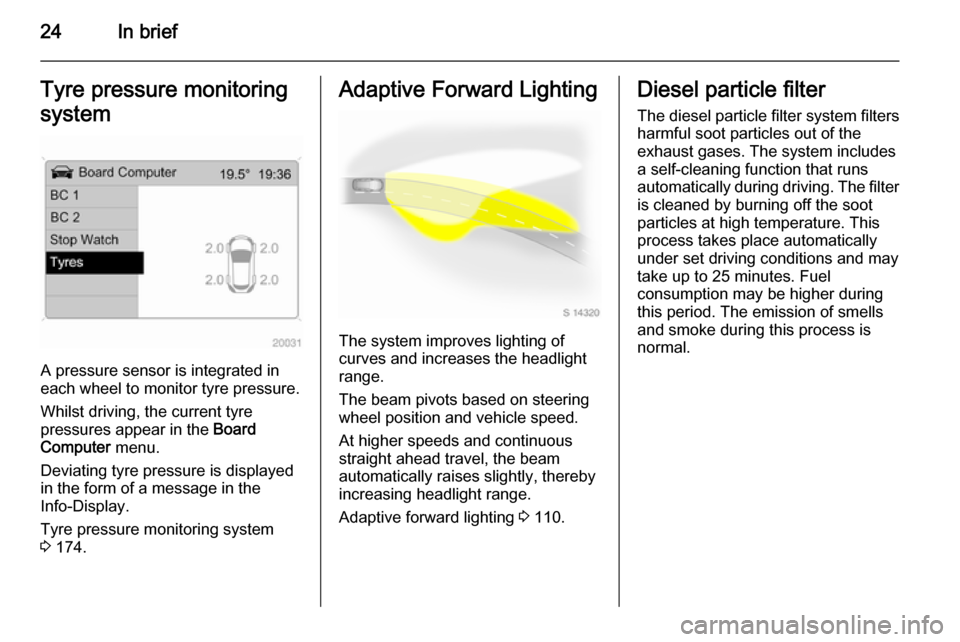
24In briefTyre pressure monitoring
system
A pressure sensor is integrated in
each wheel to monitor tyre pressure.
Whilst driving, the current tyre
pressures appear in the Board
Computer menu.
Deviating tyre pressure is displayed
in the form of a message in the
Info-Display.
Tyre pressure monitoring system
3 174.
Adaptive Forward Lighting
The system improves lighting of
curves and increases the headlight
range.
The beam pivots based on steering
wheel position and vehicle speed.
At higher speeds and continuous straight ahead travel, the beam
automatically raises slightly, thereby
increasing headlight range.
Adaptive forward lighting 3 110.
Diesel particle filter
The diesel particle filter system filters
harmful soot particles out of the
exhaust gases. The system includes
a self-cleaning function that runs
automatically during driving. The filter
is cleaned by burning off the soot
particles at high temperature. This
process takes place automatically
under set driving conditions and may take up to 25 minutes. Fuel
consumption may be higher during
this period. The emission of smells
and smoke during this process is
normal.
Page 31 of 217
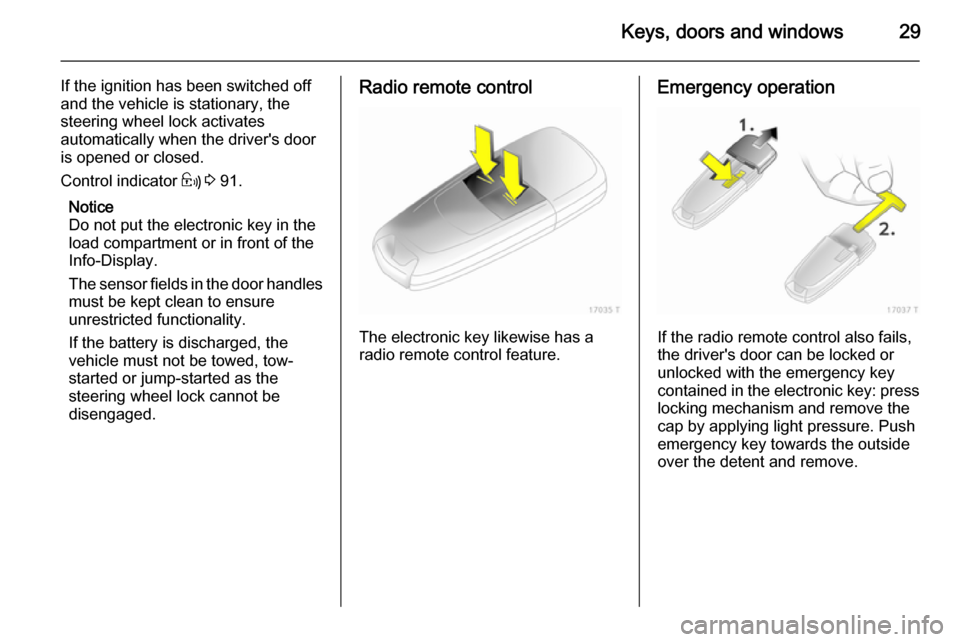
Keys, doors and windows29
If the ignition has been switched off
and the vehicle is stationary, the
steering wheel lock activates
automatically when the driver's door
is opened or closed.
Control indicator 0 3 91.
Notice
Do not put the electronic key in the
load compartment or in front of the
Info-Display.
The sensor fields in the door handles
must be kept clean to ensure
unrestricted functionality.
If the battery is discharged, the
vehicle must not be towed, tow-
started or jump-started as the
steering wheel lock cannot be
disengaged.Radio remote control
The electronic key likewise has a
radio remote control feature.
Emergency operation
If the radio remote control also fails,
the driver's door can be locked or
unlocked with the emergency key
contained in the electronic key: press locking mechanism and remove the
cap by applying light pressure. Push
emergency key towards the outside
over the detent and remove.
Page 33 of 217

Keys, doors and windows31
To replace the battery, press the
locking mechanism and remove the
cap by applying light pressure. Press
the cap on the other side outward.
Replace the battery (battery type
CR 2032), noting the installation
position. Engage caps.
Radio remote control
synchronisation
The radio remote control
synchronises itself automatically
during every starting procedure.
Fault
If the central locking cannot be
operated or the engine cannot be
started, the cause may be one of the
following:
■ Fault in remote control 3 27,
■ electronic key out of reception range.
To rectify the cause of the fault,
change the position of the electronic
key.
Central locking system Unlocks and locks doors, load
compartment and fuel filler flap.
A pull on an interior door handle
unlocks the entire vehicle and opens
the door.
Notice
In the event of an accident of a
certain severity, the vehicle unlocks
automatically.Unlocking
Radio remote control
Press button q.